The Benefits of Non-Verbal Communication in Meetings

Introduction
Non-verbal communication plays a crucial role in conveying messages, emotions, and attitudes in any conversation. In meetings, non-verbal cues can significantly impact the quality of interactions, leading to more effective collaboration and decision-making. This article will explore the benefits of non-verbal communication in meetings and provide strategies for using non-verbal cues to enhance communication among team members.
In this article, we will cover:
- The importance and types of non-verbal communication, including body language, facial expressions, tone of voice, and physical distance.
- The various benefits of effectively using non-verbal communication in meetings, such as improved understanding, increased trust, and greater engagement.
- Strategies for incorporating non-verbal communication into your meetings, including active listening, appropriate body language, and matching verbal and non-verbal messages.
- Overcoming barriers to non-verbal communication, such as cultural differences and power dynamics.
- Best practices for using non-verbal communication in meetings, as well as real-world examples of successful implementation.
By understanding and harnessing the power of non-verbal communication, business and team leaders can significantly improve the quality of their meetings, leading to stronger team dynamics and more effective decision-making.
Understanding Non-Verbal Communication
Non-verbal communication encompasses a wide range of cues and signals that convey meaning without the use of words. These cues can significantly impact how messages are interpreted and understood in meetings. In this section, we will discuss the various types of non-verbal communication, their importance in conveying emotions and attitudes, and how they can impact the meaning of verbal messages.
Types of non-verbal communication include:
- Body language: Posture, gestures, and movements can convey a variety of meanings, such as confidence, agreement, or disagreement.
- Facial expressions: Facial cues can express emotions like happiness, surprise, anger, or confusion.
- Tone of voice: The pitch, volume, and intonation of a speaker's voice can convey their emotional state and attitude towards the topic at hand.
- Physical distance: Personal space and proximity to others in a meeting can signal different levels of intimacy, comfort, or authority.
Non-verbal communication plays a crucial role in conveying emotions and attitudes. In many instances, non-verbal cues can be more powerful than verbal messages in conveying a person's true feelings or intentions. This is particularly important in meetings, where understanding the emotions and attitudes of participants can enhance collaboration and decision-making.
Furthermore, non-verbal cues can significantly impact the meaning of verbal messages. For example, a statement made with a sarcastic tone of voice may be interpreted differently than the same statement delivered sincerely. By paying close attention to non-verbal cues in meetings, participants can better understand the intended meaning behind verbal messages and avoid miscommunication.
In summary, understanding non-verbal communication is crucial for effective communication in meetings. By being aware of the various types of non-verbal cues and their potential impact on the meaning of verbal messages, meeting participants can enhance their understanding of others' emotions and attitudes, leading to more productive and successful meetings.
The Benefits of Non-Verbal Communication in Meetings
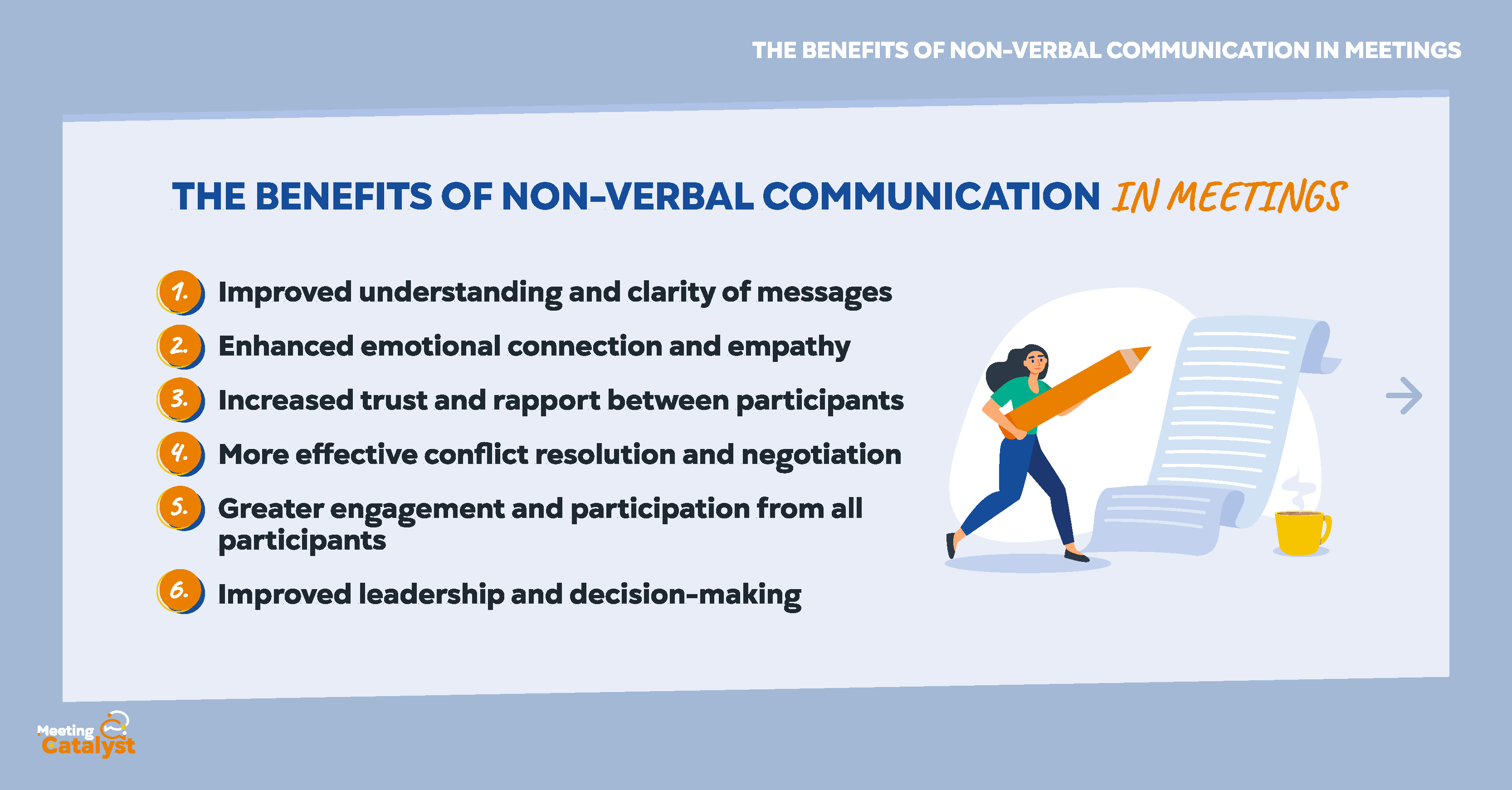
Effective use of non-verbal communication in meetings offers numerous advantages for all participants. These benefits range from improved clarity of messages to enhanced emotional connections, leading to more productive and successful meetings. In this section, we will explore several key benefits of non-verbal communication in meetings.
Improved understanding and clarity of messages: Non-verbal cues can reinforce or clarify verbal messages, helping participants better understand the intended meaning. For example, nodding in agreement while speaking can emphasize a point, while furrowing one's brow may indicate confusion.
Enhanced emotional connection and empathy: Recognizing and responding to non-verbal cues in meetings can help participants better understand each other's emotions and build empathy. This emotional connection fosters a supportive environment where individuals feel comfortable sharing their thoughts and ideas.
Increased trust and rapport between participants: Observing and mirroring appropriate non-verbal cues can create a sense of rapport and trust between meeting participants. Positive body language, such as open postures and engaged facial expressions, can signal that participants are actively listening and genuinely interested in the conversation.
More effective conflict resolution and negotiation: The ability to read and respond to non-verbal cues can help participants identify and address potential conflicts more effectively. By recognizing signs of disagreement or tension, individuals can adapt their communication style to de-escalate conflicts and facilitate constructive negotiations.
Greater engagement and participation from all participants: Paying attention to non-verbal cues can help meeting leaders identify when participants may feel disengaged or uncomfortable. By addressing these concerns and encouraging participation through non-verbal signals, leaders can create a more inclusive and engaging meeting environment.
Improved leadership and decision-making: Strong non-verbal communication skills can enhance a leader's ability to guide meetings effectively and make informed decisions. By observing non-verbal cues from participants, leaders can gauge the overall mood and receptiveness of the group, allowing them to adapt their approach accordingly.
In conclusion, the benefits of non-verbal communication in meetings are manifold. By understanding and effectively using non-verbal cues, meeting participants can enhance their communication, strengthen emotional connections, and foster more successful and productive meetings.
Strategies for Using Non-Verbal Communication in Meetings
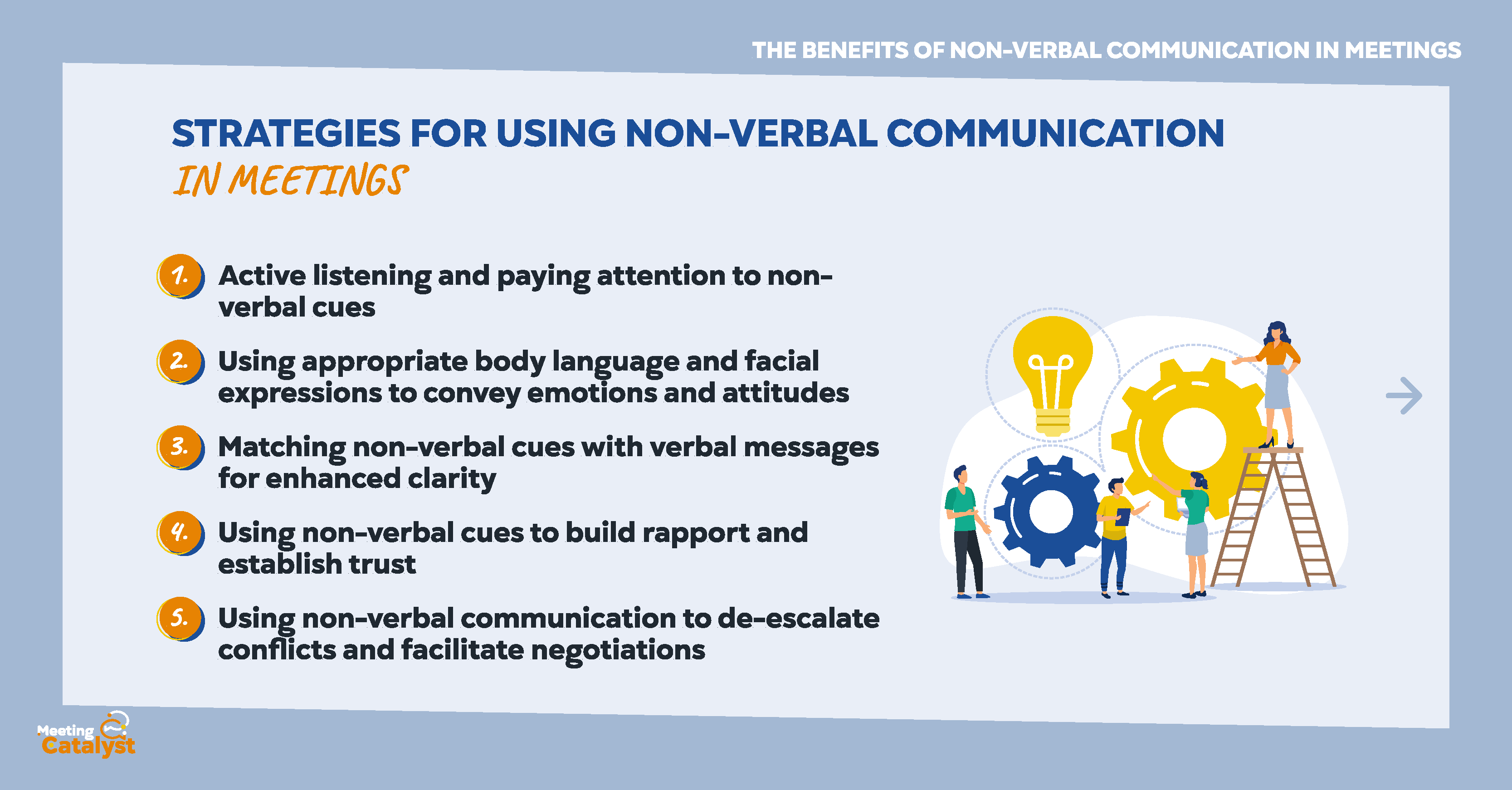
To maximize the benefits of non-verbal communication in meetings, it's crucial to develop and implement effective strategies. These strategies can help participants better understand each other's non-verbal cues and foster a more productive and engaging meeting environment. Here are several key strategies for using non-verbal communication in meetings:
Active listening and paying attention to non-verbal cues: Practice active listening by giving your full attention to the speaker and observing their non-verbal signals. This will help you better understand their message and emotions, as well as show your engagement in the conversation.
Using appropriate body language and facial expressions to convey emotions and attitudes: Be conscious of your own body language and facial expressions, ensuring they match your intended message. Maintain an open posture, make eye contact, and use gestures that convey your emotions and attitudes accurately.
Matching non-verbal cues with verbal messages for enhanced clarity: Ensure that your non-verbal cues complement your verbal communication. For example, nodding while affirming agreement or using hand gestures to emphasize key points can help reinforce your message and improve clarity.
Using non-verbal cues to build rapport and establish trust: Pay attention to the non-verbal cues of others and mirror them when appropriate. This can help build rapport and establish trust among meeting participants. For example, if someone leans in while speaking, try leaning in as well to show you're engaged and interested.
Using non-verbal communication to de-escalate conflicts and facilitate negotiations: Recognize when non-verbal cues indicate disagreement or tension, and adjust your communication style accordingly. Adopt a calm and open body language, maintain eye contact, and use a soothing tone of voice to help de-escalate conflicts and facilitate negotiations.
By implementing these strategies, meeting participants can harness the power of non-verbal communication to create a more positive, engaging, and productive meeting experience.
Overcoming Barriers to Non-Verbal Communication
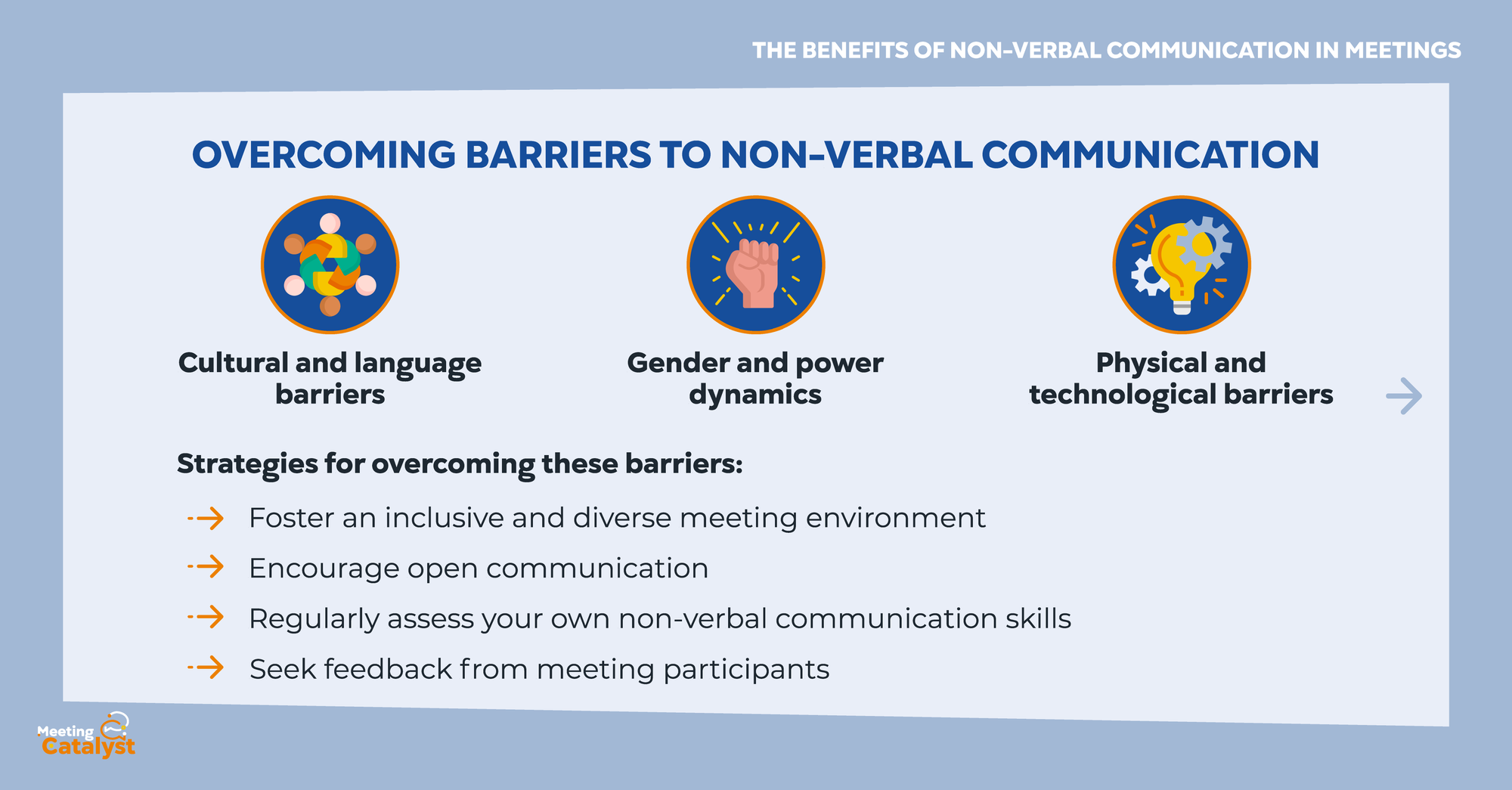
While non-verbal communication offers many benefits in meetings, there can be barriers that hinder its effectiveness. To overcome these obstacles and ensure productive communication, it's essential to recognize the barriers and implement strategies to address them. Here are some common barriers to non-verbal communication and ways to overcome them:
Cultural and language barriers: Different cultures have unique interpretations of non-verbal cues, which can lead to misunderstandings. To overcome this barrier, educate yourself about the cultural backgrounds of meeting participants and be aware of potential differences in non-verbal communication. Encourage open dialogue and ask for clarification if needed.
Gender and power dynamics: Gender and power dynamics can affect how non-verbal cues are perceived and interpreted. To address this barrier, create an inclusive environment that values diverse perspectives and encourages equal participation. Be aware of potential biases and strive to treat all participants fairly and respectfully.
Physical and technological barriers: Physical barriers, such as limited visibility or hearing difficulties, can impede non-verbal communication. In virtual meetings, technological barriers, like poor video quality or audio delays, can also hinder non-verbal cues. To overcome these barriers, ensure that the meeting space is well-lit and free of obstructions. In virtual meetings, use high-quality video and audio equipment and test connections beforehand to minimize disruptions.
Strategies for overcoming these barriers:
- Foster an inclusive and diverse meeting environment where everyone feels comfortable expressing themselves through non-verbal communication.
- Encourage open communication and provide opportunities for participants to clarify misunderstandings.
- Regularly assess your own non-verbal communication skills and make adjustments as needed.
- Seek feedback from meeting participants to identify areas for improvement in non-verbal communication.
By understanding and addressing these barriers, you can create a more effective and inclusive meeting environment that leverages the full potential of non-verbal communication.
Best Practices for Using Non-Verbal Communication in Meetings
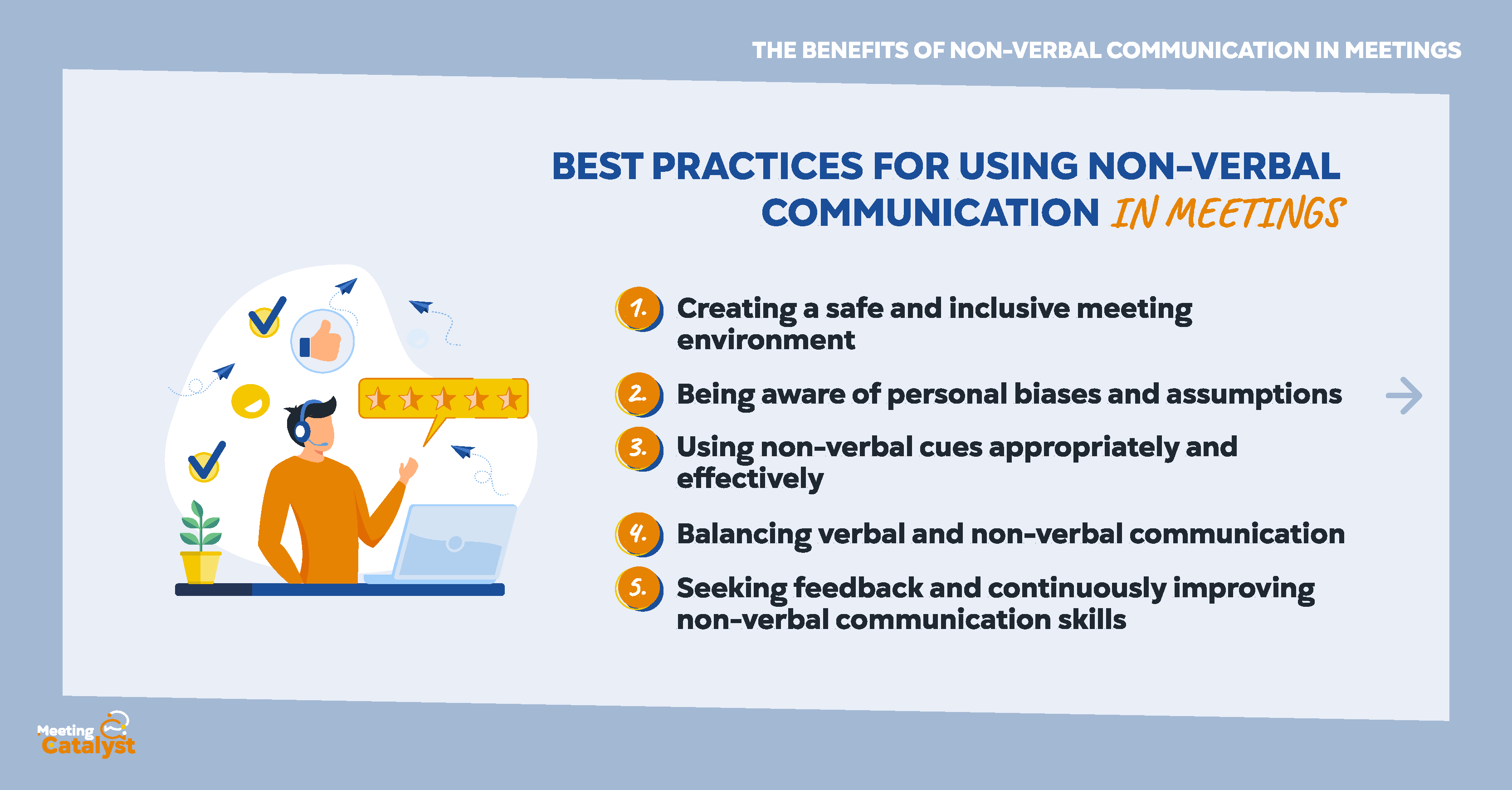
To fully harness the power of non-verbal communication in meetings, it's important to follow best practices that promote effective and inclusive interactions. Here are some best practices for using non-verbal communication in meetings:
Creating a safe and inclusive meeting environment: Ensure that your meeting space, whether physical or virtual, is comfortable and free of distractions. This will encourage participants to feel at ease and communicate more effectively through both verbal and non-verbal means.
Being aware of personal biases and assumptions: Recognize that your own biases and assumptions may influence how you interpret non-verbal cues. Strive to maintain an open mind and avoid jumping to conclusions based on non-verbal signals alone.
Using non-verbal cues appropriately and effectively: Be conscious of your body language, facial expressions, and tone of voice, and use them deliberately to convey your intended message. Align your non-verbal cues with your verbal communication to create a cohesive and clear message.
Balancing verbal and non-verbal communication: While non-verbal communication is crucial, it should complement, not replace, verbal communication. Strive to achieve a balance between the two forms of communication to ensure that your message is accurately and effectively conveyed.
Seeking feedback and continuously improving non-verbal communication skills: Regularly assess your non-verbal communication abilities and seek feedback from others to identify areas for improvement. Continuously work on refining your skills to become a more effective communicator in meetings.
By implementing these best practices, you can enhance the effectiveness of non-verbal communication in your meetings and create a more inclusive and productive environment for all participants.
Case Studies Examples of Successful Use of Non-Verbal Communication in Meetings
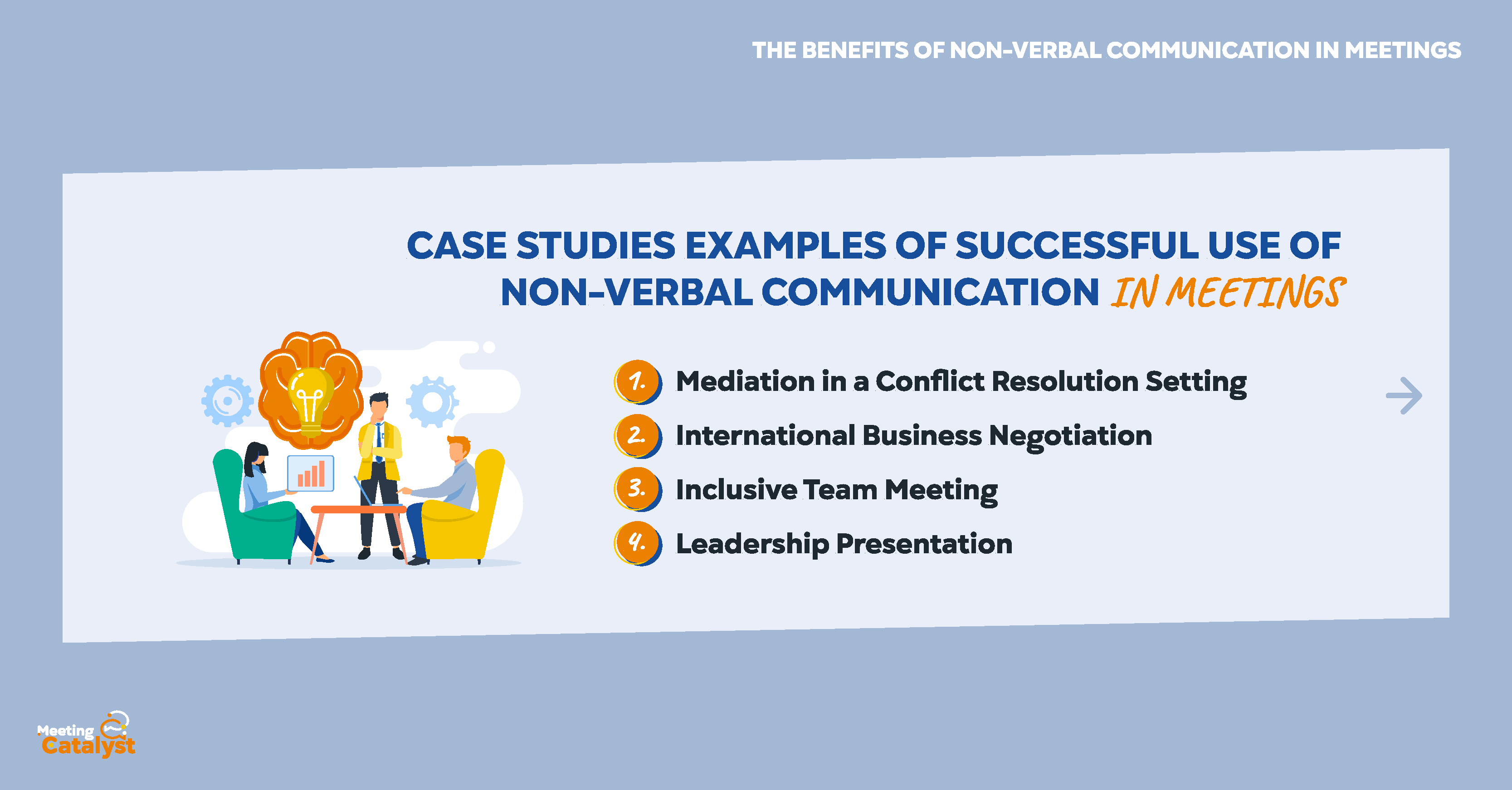
To further illustrate the power of non-verbal communication in meetings, let's explore some real-world examples of organizations or individuals who have effectively used non-verbal communication to achieve successful outcomes:
Mediation in a Conflict Resolution Setting: In a tense meeting between two parties in a workplace dispute, the mediator effectively used non-verbal cues to establish trust and rapport with both sides. By maintaining open body language, making eye contact, and nodding in understanding, the mediator fostered a sense of empathy and helped the parties feel heard, leading to a successful resolution.
International Business Negotiation: During an important international negotiation, the representatives of a company were mindful of cultural differences in non-verbal communication. They researched the appropriate body language, gestures, and personal space for the specific culture they were dealing with, which helped them build rapport and demonstrate respect, ultimately leading to a successful deal.
Inclusive Team Meeting: A team leader ensured that all team members felt included and valued during a virtual meeting by using non-verbal cues, such as nodding in agreement, maintaining eye contact with each participant, and using facial expressions that conveyed understanding and support. This resulted in increased participation and engagement from all team members, leading to more effective collaboration and decision-making.
Leadership Presentation: During a company-wide presentation, a CEO used non-verbal communication effectively to convey confidence, passion, and vision to the audience. By standing tall, using open gestures, and maintaining eye contact with the audience, the CEO inspired trust and enthusiasm in the company's direction, leading to increased employee engagement and commitment.
These case studies demonstrate that the strategic use of non-verbal communication in meetings can lead to positive outcomes, whether in conflict resolution, negotiation, team collaboration, or leadership presentations. By applying the principles and best practices of non-verbal communication in your own meetings, you can enhance the effectiveness of your communication and achieve better results.
Conclusion
In conclusion, non-verbal communication plays a vital role in enhancing the effectiveness of meetings, helping participants better understand each other, and fostering trust and rapport. By recognizing the importance of non-verbal cues and strategically using them, you can significantly improve your meetings and achieve better outcomes.
Throughout this article, we've explored the benefits of non-verbal communication in meetings, including improved understanding and clarity of messages, enhanced emotional connection and empathy, increased trust and rapport, and more effective conflict resolution and negotiation. We've also provided practical strategies for using non-verbal communication effectively and overcoming common barriers.
As a business or team leader, it's crucial to invest time and effort in understanding and mastering non-verbal communication. By implementing the best practices and strategies discussed in this article, you can unlock the full potential of non-verbal communication to create more productive, engaging, and inclusive meetings.
So, take the first step today by becoming more aware of the non-verbal cues in your meetings and consciously using them to your advantage. With practice and dedication, you can transform your meetings and reap the many benefits of effective non-verbal communication.